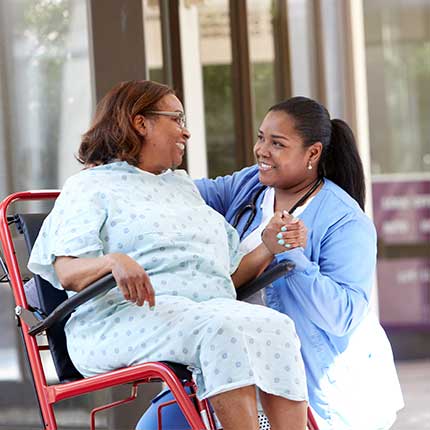Healthy Living
Walking and Sports - What Could Happen?
Enjoying time outside, whether engaging in your favorite sports or taking a nice afternoon hike, may seem like your usual summer plans. However, the twists and turns of being outside can catch you by surprise and may result in injury or an emergency. If you’re an active, outdoor person, the information below can help you stay prepared for walking-related or sports injuries.
1. Walking
Walking brings many benefits, such as weight management, muscle strength and improved circulation. Walking has also been proven to strengthen your heart and boost your immune function. However, it only takes a rock or an acorn, and you’re caught off guard with a twisted ankle or a swollen foot.
What can happen on a walk?
Whether enjoying a brisk walk or a stroll, keep in mind a few pointers:
- Watch your step. Stepping on a foreign object can cause a fall.
- Make sure your shoes fit you well and are well maintained. If your shoes no longer fit, are worn out or are too large a size, you are more susceptible to accidents.
How to Handle Injuries from Walking
- If you experience a walking injury, avoid putting pressure on the affected area for two to three weeks or until manageable.
- Icing the injury for 20 minutes a few times a day can also help with recovery.
- Taking anti-inflammatory medication can help with the pain and swelling.
- Need to move around? Crutches will be your new best friend for the next few weeks.
- Keeping pressure on your injury with a bandage or elastic sleeve can help with the healing process. Just make sure it isn’t applied too tightly as you don’t want to cut off circulation.
On the other hand, severe injuries that involve joint swelling or extreme pain need immediate medical attention. And, experiencing back or neck pain, especially if there is pain that runs down the arm or leg, warrants immediate medical attention.
2. Sports Injuries
Summer sports, such as soccer, tennis, cycling and running make a great source of exercise and camaraderie, but they can also be a source of injuries. There are two types of injuries you can sustain: Acute injuries happen suddenly, while chronic injuries develop over time. Some of the most common sports injuries include:
- Sprains - This is the result of a stretch or tear of a ligament near a joint and is most often caused by falling or by a twisting motion. Symptoms are pain, swelling, and bruising.
- Runner’s knee - This can be common to runners and anyone who does a lot of walking, biking, or general knee bending. Symptoms include pain behind your kneecap, especially when you bend your knee.
- Dislocations - These happen when the ends of your bones move out of their normal position. Symptoms include extreme pain, swelling, and not being able to move the area.
- Achilles tendon - These injuries are common in sports that require a lot of running. Symptoms include swelling in the area or if the area is warm to the touch.
- Broken bones - A fall or blunt force can cause sudden pain, swelling, numbness and tenderness around the area. Go to the emergency room for suspected broken bones.
How to Avoid Sports Injuries
Although accidents can happen to anyone at any given time, exercising caution can go a long way when trying to avoid sports injuries. The following tips are reminders to keep you safe during your next hike or soccer game with friends:
- Make sure you stretch before and after you exercise.
- Always use proper protective gear, such as a helmet for cycling or when at bat for baseball or softball.
- Stay hydrated. Stopping for a drink every 20 minutes during your activity is good practice.
- Be mindful about the environment you’re in, watching for objects that could be falling hazards.
- Keep a first-aid kit stocked with items you may need for minor injuries.
How to Handle Sports Injuries
If you get injured while playing a sport, stop right away. Riding out the pain of waiting to see if it will subside while still engaged in the sport may only worsen your condition. Most minor sports injuries can be managed at home and should get better in a few days, but for injuries that bring you swelling and pain, it’s best to seek medical attention.
Knowing how to perform basic first aid can also help prevent injuries from getting worse. However, if the injury is severe or life-threatening, call 911 immediately.
When to See a Doctor for Sports Injuries
Don’t delay seeking medical help when you have an emergency. Go to the doctor right away the moment your injury causes extreme swelling, bruising or pain.
Safe Orthopedic Care
Our hospital is safe and ready for you 24/7. Providing our patients with outstanding compassionate care when and where they need it is why we’re here. In addition to medical solutions, we strive for a heartwarming, healing experience. Your safe care is our #1 priority.
If you need help for your injuries, please don’t delay. Seek medical care.
Sources:
American Academy of Family Physicians
Harvard Health



